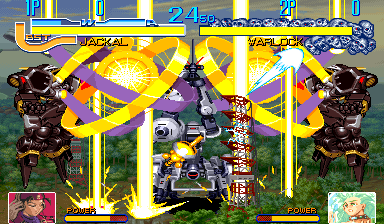So far we’ve concentrated primarily on that vital spot right outside the opponent’s poke range. Now it’s time to explore some close quarters combat.
Element 16: If your character has a damaging combo starting with c.LK, a good way land it is by taking a step forward after forcing your opponent to block a light attack or a jump attack, or even after a knockdown. This makes a lot of players twitch because it looks like you’re going for a throw, plus nobody likes letting someone walk all over their personal space. Closing the gap carries the additional advantage of enabling you to maintain offensive pressure with longer attack strings. The exact duration of your walk depends on your opponent’s habits. If they like mashing buttons during block stun, then time your c.LK to stuff their jab startup. If they’re extremely patient, then you’ll need to taunt them by walking forward for quite a while.
 Element 17: One of the dirtiest tricks i’ve ever seen was Daigo‘s ST Ryu knocking down Jason Cole‘s Dhalsim, crossing him up with a blocked j.HK, then walking backward for half an eternity before nailing him with c.MK xx Fire Hadoken. It connected because Daigo timed that c.MK to coincide with Dhalsim’s recovery from j.HK block stun, so Cole got hit low as he stood up to counter-throw. This is another way to punish defensive throw attempts and it works even in games without throw whiff animation. Of course this is a variation of the element outlined above, but it’s slightly more versatile because some characters don’t really have c.LK combos. Since you’re probably not hit-confirming the combo here, make sure to finish with a move that leaves you safe if blocked.
Element 17: One of the dirtiest tricks i’ve ever seen was Daigo‘s ST Ryu knocking down Jason Cole‘s Dhalsim, crossing him up with a blocked j.HK, then walking backward for half an eternity before nailing him with c.MK xx Fire Hadoken. It connected because Daigo timed that c.MK to coincide with Dhalsim’s recovery from j.HK block stun, so Cole got hit low as he stood up to counter-throw. This is another way to punish defensive throw attempts and it works even in games without throw whiff animation. Of course this is a variation of the element outlined above, but it’s slightly more versatile because some characters don’t really have c.LK combos. Since you’re probably not hit-confirming the combo here, make sure to finish with a move that leaves you safe if blocked.
Element 18: Uppercut that shit!
Once you scare your opponent out of pushing buttons at close range, you get to walk forward at will. That’s when the real fun begins.
Rule #4: Tactics are more reliable than gimmicks, so build your gameplan around tactics. The ideal definition of a solid tactic is a 50/50 mixup wherein both options are equally damaging, equally safe, favorable to your position over the opponent’s, and designed such that no single defensive maneuver counters both options. There aren’t many perfect examples out there, but three characters immediately come to mind: ST Vega, CvS1 Nakoruru, and MvC2 Magneto.
Conversely a gimmick works only once, because it’s a trick designed to counter the opponent’s most common reaction without properly accounting for alternatives. Of course shenanigans have their uses, but only until your opponent realizes that you’re bluffing about having anything else to resort to.
Your goal should be to get as close to a fully tactical gameplan as possible, because that’ll actually make your shenanigans considerably more effective as well. Remember, you don’t get in trouble for using shenanigans – you get in trouble for depending on them.

 Element 17: One of the dirtiest tricks i’ve ever seen was Daigo‘s ST Ryu knocking down Jason Cole‘s Dhalsim, crossing him up with a blocked j.HK, then
Element 17: One of the dirtiest tricks i’ve ever seen was Daigo‘s ST Ryu knocking down Jason Cole‘s Dhalsim, crossing him up with a blocked j.HK, then